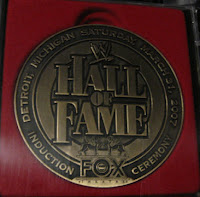In order to boost ticket sales for the ceremony, WWE has already announced their "main event"
 Hall of Fame slot for 2011. Shawn Michaels will enter the "Hall" in the top spot for 2011 in just his first year of retirement. In the next few weeks, a handful of shining stars will be added to the group.
Hall of Fame slot for 2011. Shawn Michaels will enter the "Hall" in the top spot for 2011 in just his first year of retirement. In the next few weeks, a handful of shining stars will be added to the group.While some fans denounce the WWE's version of Cooperstown or Canton (albeit without a building) as being a joke, I'd have to question the fandom of anyone who would deny that the WWE Hall of Fame provides a fun and often touching night of nostalgia.
From Bobby Heenan's show-stealing acceptance speech in 2004 to one last "lock-up" of Ric Flair and inductee Ricky Steamboat in 2009, the Hall of Fame has more than validated itself as a night to celebrate the industry we all love. Controversy, politics, and "Celebrity Wing" aside, when the Legends are brought out for one more standing ovation it should be a celebrated event.
 The WWF Hall of Fame was created in 1993 following the passing of Andre the Giant. Always standing alone, the 1993 Class WAS Andre. 1994 through 1996 brought three full classes of stars who personified the building blocks of Titan Sports. While the early ceremonies were simply dinners held in small hotel ballrooms, legends such as Gorilla Monsoon, The Fabulous Moolah, and Fred Blassie were allowed one more time to shine. Beginning in 2004, the event was packaged as an annual event held the night before WrestleMania. The venues began to grow, for better or worse, as did the span of stars inducted.
The WWF Hall of Fame was created in 1993 following the passing of Andre the Giant. Always standing alone, the 1993 Class WAS Andre. 1994 through 1996 brought three full classes of stars who personified the building blocks of Titan Sports. While the early ceremonies were simply dinners held in small hotel ballrooms, legends such as Gorilla Monsoon, The Fabulous Moolah, and Fred Blassie were allowed one more time to shine. Beginning in 2004, the event was packaged as an annual event held the night before WrestleMania. The venues began to grow, for better or worse, as did the span of stars inducted.The event also began to spawn its own merchandise. While small programs do exist in EXTREMELY limited quantities from the first ceremonies, it was not until 2004 that full
 multi-page programs were created to commemorate the evening. In 2009 the program became an item sold by WWE rather than given to attendees.
multi-page programs were created to commemorate the evening. In 2009 the program became an item sold by WWE rather than given to attendees.Another unique item to come from the Hall of Fame were medallions given to attendees from 2004-2007. While at one time a collector with enough patience could pick these up at auction, they rarely show up today and will undoubtedly only rise in value.

Many autograph collectors use the programs as projects to try and obtain the signatures of each honoree on their respective induction year program. Often, the inductees themselves do not own copies of the programs.
With many more ring warriors to be announced in the coming weeks, the 2011 Hall of Fame should shape up to be yet another great night of memories...and memorabilia.

For more great photos of the WWF/WWE Hall of Fame memorabilia mentioned, please visit and join our Facebook Fanpage.





















